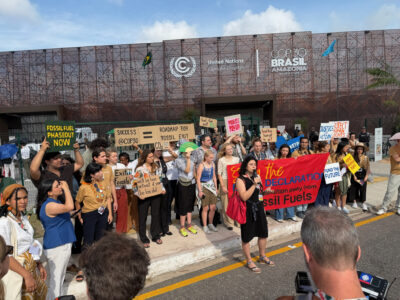COP30 Outcomes – An architecture for implementation
Published on: November 24, 2025
Andreas Gyllenhammar, Chief Sustainability Officer at Sweco, attended the negotiations in Belém and provides an in-depth analysis of the key outcomes and business implications of this year’s UN Climate Conference, COP30.
The world is not winning the fight against the climate crisis, but it is undeniably still in it, the UN climate chief Simon Stiell said in Belém, Brazil, after countries at COP30 reached a deal on Saturday.
The Global Mutirão is the core political result of COP30 which also turned out to be the anchor for implementation of the Paris Agreement towards 2030. The core message is that ”countries must now deliver – not just promise” which is anchored by a number of new mechanisms related to implementation, acceleration and social foundations.
Background
I’ve been a regular COP attendee since 2009 as a representative of the international business community. As Chief Sustainability Officer of Sweco, a long standing member of the WBCSD and being a climate analyst, I’ve been part of the BINGO (Business Industry Non Governmental Organisation) observer group. We have access to the negotiation rooms, can follow the progress and make statements on behalf of the business community. Equally important is that we take part in the extensive side-event arena of the COP where climate matters are discussed, best practices are shared and different stakeholders exchange ideas, knowledge and experiences. For Sweco, it’s important to participate, analyse effects of outcomes and to contribute with our collective competence on climate transition and adaptation.
COP RESULTS IN A NUTSHELL
- An accelerator as a center-piece for emission reductions
The Global Implementation Accelerator (GIA) is a two-year implementation engine to serve as a structure for raising ambitions and supporting national work with delivering on their climate targets. It aims to enable matchmaking between finance, technology and national needs. It will also integrate cities, business, multilateral banks and investors into delivery. This is the closed the UNFCCC has ever come to an operational delivery mechanism.
- A multi-year Climate-Trade-Investment dialogue
Expected to have an impact on global trade within the green transition, this aims to elevate climate from being an environmental silo (like EUs CBAM) to cover more holistic global industrial policy. The dialogue will encompass supply chains, industrial competitiveness, product standards, carbon-based trade rules and regulatory convergence.
- Alignment of financial flows
The outcome reaffirms that all financial flows must become consistent with low-GHG, climate-resilient development. This gives regulators, central banks and development banks more reasons to push for climate-aligned finance flows on different scales.
- A more structured work program on climate finance
After two weeks of intense negotiations, the adopted text calls for mobilizing at least $1.3 trillion annually by 2035 for climate action, alongside tripling adaptation finance and operationalizing the loss and damage fund agreed at COP28. Parties launch a work program to scale public finance, mobilize private capital, lower financial risk and improve access to capital for developing countries. Enhancing the transparency of financial flows is also important.
This is the finance side equivalent of holding parties accountable for their climate targets. Finance is now given the same architecture as emissions.
- Climate adaptation becomes measurable in a comparable way
Negotiators agreed on a consolidated list of 60 indicators to track progress on the Global Goal of Adaptation (GGA). The indicators are voluntary and cover water, health, food systems, ecosystems, risk assessments, planning, implementation and systems for monitoring and evaluating adaptation work.
This was the decision that surprised me most. How could they agree so smoothly on this very tricky issue? The answer is that it wasn’t smooth. During the final plenary many parties were very disappointed of the process in the final step where suddenly everything was heavily reduced and they weren’t given time to analyse and respond. This might call for a weaker outcome of the indicators.
- A just transition
The language in the decision stresses that emission reductions must be made in Solidarity, Collective effort, Supporting developing countries and Addressing systemic inequalities. This was to get developing countries to accept the whole package.
When I read the Mutirão document, I notice the shift from ambition to implementation. From mitigation to adaptation. And with trade and justice as new important policy factors. The success will depend on a multitude of interlinked global and financial developments. The architecture is now in place, with mechanisms, finance and political signals to mainstream climate across the global economy.
- Business implications
What businesses usually want from policy is easily summarized in one word: predictability. A clear direction and rules, long-term economic stimulations/taxes and a level playing field. These are three observations to bear in mind regarding climate impacts on the business sector:
The green transition is on. I see no signs in the outcome agreements of a altered direction. The Paris Agreement is still alive. Although COP30 didn’t deliver a clear fossil-fuel roadmap, it also didn’t reverse any of the long-term net-zero signals from Paris and Glasgow COPs. The deal keeps 1.5°C ”alive on paper” while leaving mitigation ambition to national politics – albeit with help in form of shared accelerator mechanisms. For companies, this means that the decarbonization direction remains intact. More policy noise and uneven climate ambition across markets is to be expected rather than a clean, global and synchronized path of travel.
Finance is coupled to fairness. Fairness in terms of just transition, trade and CBAM-style measures. As a result, companies could expect more conditionality being developed over time. ”You want funding? Do you have X goals, plans and activities?” Where X could equal social, resilience, climate adapted, just transition etc. Also keep an eye on the upcoming trade discussions. Although CBAM survived this time, expect it to be brought up in relation to trade discussions far outside the realms of the climate world.
Fragmented leadership leads to regional regimes and increased complexity. US has abdicated, EU was partly uncoordinated and unable to take the leadership, China not really wanting it and the BRICS countries emerging as a new strong player. I see that this means we are tilting towards a multipolar patchwork of climate policy. Are you a global business? Prepare for parallel rule-systems.
The COP outcome will be an outer boundary, but the real business risk/opportunity will lie in national regulations and capital markets. Keep in mind the underlying drivers for a long-term green transition. EU has a lot of climate action locked in in existing legislations and funding. EU also ties the climate transition to its industrial strategies, its competitiveness, independence and security (resilience). Furthermore, the cost curves for cleantech still favour low-carbon investments, by far.
FINAL REFLECTIONS
I’ve attended many climate summits, and they are all a bit different in terms of geopolitical context, leadership and dynamics but there are a few long-term trends that is visible over a multi-year perspective.
COPs matter over time
Seen in isolation, almost all COPs are regarded as failures by many, which can be attributed to the built-in UN consensus process but also to the fact that climate is now intertwined into a much larger economic context (which is exemplified by this year’s hot discussions on unilateral trade). Starting out with climate mitigation, the negotiations have been complemented with adaptation and handling loss & damage.
From the beginning, COP was centered around countries but over the years it has continuously added more and more pressure, and help, from other stakeholders like cities, businesses, organisations and indigenous people. How far can you get in two weeks when all these matters are on the table? COP almost always finds a way. What starts out as a new and burning issue, gets picked up after a year, is scoped and framed and eventually leads to decisions. Not clearly visible if the COPs are treated as singular events but the patterns that emerge will eventually shape and set the climate policy agenda. The COP also learns over time what works and what not. As in Dubai when the goal discussion moved from phasing out fossil fuels to tripling renewables. From limiting the bad to accelerating the good.
My final take-away from this turbulent COP in turbulent times? We are seeing the architecture and mechanisms on accelerated implementation on mitigation and adaptation emerge. In that perspective, not a bad outcome.
About the author of this article
Andreas Gyllenhammar has been attending UNFCCC COP meetings since 2009 as an observer for the business and industry group or as a part of the Swedish delegation. He is Sweco’s liaison officer for WBCSD (the World Business Council on Sustainable Development) and a renowned climate analyst, working with clients to shape climate strategies by interpret science, market shifts to identify and capture opportunities in the transition towards a fossil free future.




